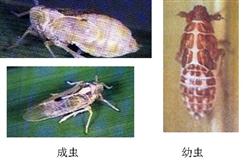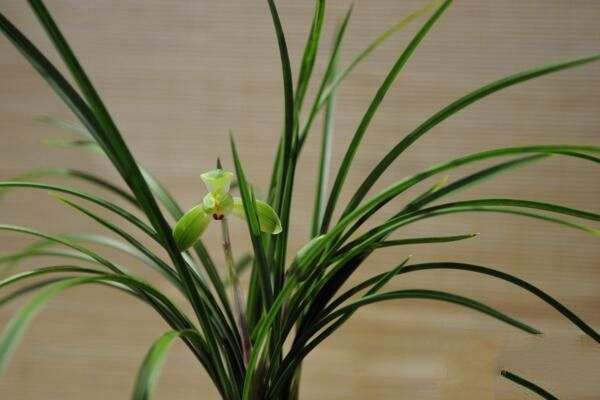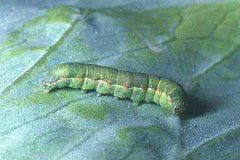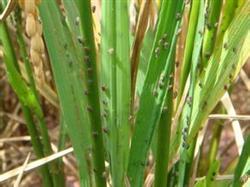Brown back Learn more about Brown back
-
How does Brown-backed Shrike divide male and female?

Brown-backed Shrike is a bird of the genus Shrike, commonly known as Guilam and Huang Shilao, which is literally translated as long-tailed Shrike. Brown back Shrike is characterized by a thick black eye pattern or crown, black wings, long tail black, gray upper body and brown lower body. Widely distributed along the eastern part of China
2020-11-11 Brown back Shrike how Fen male and female yes Shrike. -
What are the animals?

What are the animals?
2018-07-03 -
How to control rice brown planthopper and white-backed planthopper?

How to control rice brown planthopper and white-backed planthopper? Please introduce the method that brown planthopper occurs at grade 5 in two consecutive years, and has strong resistance to insecticide, while white-backed planthopper occurs in grade 3 to 4 in a row for many years. The main factors affecting the occurrence are migration and climatic conditions in summer and autumn. Brown planthopper broke out in the rice area of Vietnam in the winter of 2006.
2018-07-19 -
Hessex chicken

The commercial substitute chickens with brown shell eggs imported from Uribrid in the Netherlands can distinguish between male and female according to their color: hens color-90% are all brown-red, 8% are brown with white stripes on the back, and 2% are white but red or brown in the head. Rooster color-all: yellow accounted for 90%, white all over, but brown stripes on the back accounted for 8%. The whole body is white, but there are four narrow brown lines on the back, some of which are clear and some are not clear. Production performance: up to 50% laying rate at 158 days old, 2
2019-01-15 -
Rice white-backed planthopper

Host rice, English white, corn, barley, wheat, sugarcane, sorghum, barnyard grass, Kentucky bluegrass and so on. The damage characteristics are the same as those of brown planthopper. Morphological characteristics the long-winged male is 3. 2-3.8mm long, light yellow with black and brown spots. Protrusion of the top of the head, forechest, middle chest dorsal plate lateral ridge external compound eye with 1 crescent dark brown spot, middle chest dorsal plate side area dark brown, middle yellow longitudinal band, front wing translucent, end brown halo spot; wing disease, face, chest, abdomen ventral dark brown. The long-winged female has a body length of 4mur4.
2019-01-16 -
Special Topics on Orchid Diseases and insect pests

Orchid diseases and insect pests special picture treatment, white silk disease usually preventive medicine: pesticide name: methyl Likuling EC; action characteristics: internal absorption 20% sterilization.
2018-04-02 -
Special Topics on Orchid Diseases and insect pests

Look at the special topic of orchid diseases and insect pests and treat the disease "two".
2018-04-02 -
How to control rice white-backed planthopper

The scientific name Sogatellafurcifera (Horv6th) belongs to Homoptera, Homoptera. It is distributed in Yingbai and rice growing areas of China. Host rice, English white, corn, barley, wheat, sugarcane, sorghum, barnyard grass, Kentucky bluegrass and so on. The damage characteristics are the same as those of brown planthopper. Morphological characteristics the long-winged male is 3. 2-3.8mm long, light yellow with black and brown spots. Protrusion of the top of the head, forechest and middle thoracic dorsal plate lateral ridge with 1 crescent dark brown spot behind the compound eye, black and brown in the lateral area of the middle thoracic dorsal plate.
2019-01-16 -
Tea bugs and yellow spot bugs

Distribution area: morphological characteristics: the adult of tea wing bug is about 15 mm in length and 8 mm in width. The body is flat and oval. Grayish brown with purplish red. The antennae are 5, the second is longer than the third, and the ends of the 4th and the base of the 5th are yellow. The chest, back and front wings are covered with dark brown scratches. The egg is cup-shaped and gray. 20-30 eggs were arranged into egg blocks. The nymph is slightly oblate and dark brown with black spots on the back. The adult is 20mm in length and 8mm in width. Grayish brown, dense back and front wings
2019-01-15 -
The species of wild geese and their pictures

The species of wild geese and their pictures
2018-07-07 -
Harmful symptoms and preventive measures of orchid brown rust

Harmful symptoms and preventive measures of orchid brown rust
2020-07-22 -
Pest control of Plutella xylostella

Phoenix wood is known as one of the most colorful trees in the world. Its name comes from bright red or orange flowers with bright green pinnately compound leaves. It is often planted in Guangdong, Fujian, Sichuan and other places. Phoenix wood has fewer diseases and insect pests, but night moth pests are more common.
2018-07-16 -
Prevention and control of main diseases and insect pests of rhododendron

(1) ① brown spot of rhododendron: it is the main disease of rhododendron. At the beginning of the disease, small brown spots appeared on the leaf surface, and then gradually expanded into large dark brown patches, and many black or grayish brown spots were scattered on the disease spot. The damaged leaves turn yellow and fall off easily, which not only affects the flowering of the same year.
2019-03-03 -
A collection of pictures of fox breeds

A collection of pictures of fox breeds
2018-07-07 -
Characteristics of beet armyworm: what are the larvae and adults of Spodoptera exigua

Beet armyworm is a pest, we know it, but do you know its ecological habits and morphology? Let's take a look. Ecological habits: the adults of beet armyworm lie dormant during the day and go out at night, live on the back of leaves or in the dark during the day, and begin to move and mate after sunset.
2019-01-20 Beet nocturnal moth characteristic larva and adult what kind of -
Rice brown planthopper

Rice brown planthopper is also known as brown planthopper, commonly known as Ascaris lumbricoides, soft shell Ascaris, Ascaris, midges. Scientific name Nilaparvatalugens (Stdl) Homoptera, Homoptera. Brown planthopper (Nilaparvata lugens) is one of the main rice pests in China.
2018-09-13 -
Control of rice white-backed planthopper

Symptoms of damage: sucking juice at the base of rice plants inhabited by adults and nymphs, resulting in chlorosis and yellowing of leaf tips, serious withering of the whole plant, difficulty in heading, withered booting or brown panicles at panicle stage, and blighted grain. Morphological characteristics: adults can be divided into two types: long wing type and short wing type. The long-winged adult is 4-5mm long, grayish yellow, the top of the head is narrow, protruding in front of the compound eye, there are three protruding longitudinal ridges on the face, the ridge color is light, the groove color is deep, black and white, and there is a pentagonal white or blue-white spot in the center of the chest and back shield.
2019-01-16 -
The latest control method of peanut brown spot disease

Peanut brown spot is a fungal disease, caused by Cercospora arachidis infection, damage peanut leaves, initially chlorotic spots, then expanded into nearly circular or irregular small spots, the disease spots are larger and lighter than black spot, the front of the leaves are dark brown or tea brown, the back
2020-11-10 latest peanut brown spot disease control method -
Populus tomentosa

Scientific name: PryeriasinicaMoore morphological characteristics: the adult is about 12 mm long, the wingspan is about 30 mm, the head, chest and antennae are black-brown, the antennae of male moths are feathery and the antennae of female moths are pectinate. There are orange long hairs on both sides of the chest, back and abdomen, and the front wings are translucent, but the wing base 1 and 3 are yellow, the rest are dark gray, the veins of the wings are dark brown, and the background of the hind wings is yellow. The egg is oval and flat, yellowish white at first birth, and then light brown. The larva is about 20 mm long, with a small head, dark brown, yellowish green and white on the side and back.
2019-01-11 -
Chinese wolfberry planthopper

Also known as jaundice, belongs to the family Homoptera. The scientific name of pest PoratriozasinicaYangetLi. To harm crops such as wolfberry and Solanum nigrum. In the identification of insect pests, adults and nymphs pricked and sucked juice on the back of leaves, shoots and buds, which led to the decline of plant growth and the yellowing of leaves. The secretion of honeydew causes soot disease in the lower leaves. The adult is about 3.8 mm long, yellowish brown to dark brown, with orange markings. There is a pair of papillae in front of the forehead; the basal and distal segments of the antennae are black and the rest are yellow. The front and middle legs are the same color as the body, and the hind legs are slightly black.
2019-01-15
